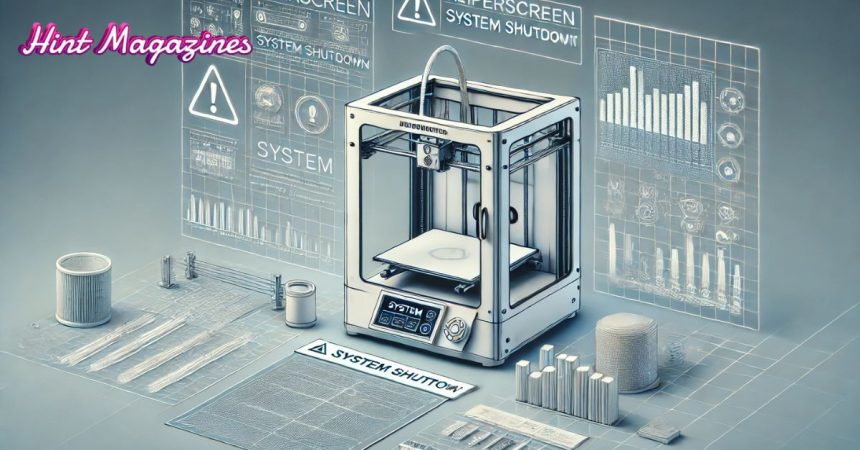The Klipperscreen system is an essential part of many 3D printers that use the Klipper firmware, offering a user-friendly interface to control the printer. However, some users may experience a frustrating issue: the Klipperscreen system shutdown. This post will delve into the causes, troubleshooting steps, and preventative measures to address this problem effectively.
What is Klipperscreen and Why Does It Matter?
Klipperscreen is a touchscreen interface designed to work with the Klipper firmware, a popular open-source 3D printing firmware. The firmware enhances the performance and capabilities of 3D printers, offering more precision, speed, and features than standard printer firmware. Klipperscreen provides a graphical interface, allowing users to easily monitor and control their 3D printer’s functions, all from a touchscreen.
While it’s a valuable tool for improving the user experience, Klipperscreen has challenges, including the occasional system shutdown.
What Causes the Klipperscreen System Shutdown?
Understanding the underlying reasons for a Klipperscreen system shutdown is essential for troubleshooting and preventing future issues. Several factors could contribute to this problem, including hardware malfunctions, software issues, and improper configurations.
Power Supply Issues
A frequent cause of system shutdowns is inadequate power supply. Since Klipperscreen relies on a stable power source to function correctly, any fluctuations or inconsistencies can result in unexpected shutdowns.
- Loose connections: Loosely connected fires can cause intermittent power supply issues.
- Insufficient voltage: If the power supply doesn’t deliver the required voltage to the screen or the Raspberry Pi, it could lead to a shutdown.
Software Configuration Problems
Klipperscreen depends on specific software configurations to operate smoothly. Incorrect configurations in the Klipper firmware or the Klipperscreen interface could trigger a system shutdown.
- Mismatched versions: Using incompatible versions of Klipper firmware and Klipperscreen can lead to compatibility issues, resulting in crashes or shutdowns.
- Improper settings: If settings such as screen timeout, screen brightness, or power-saving options are incorrectly configured, the system may shut down unexpectedly.
Overheating
Overheating is a common problem for any electronic system, and Klipperscreen is no exception. If the Raspberry Pi or the touchscreen itself overheats, the system may shut down as a safety measure to prevent damage.
- Lack of cooling: Poor ventilation or inadequate cooling for the Raspberry Pi can cause it to overheat.
- Heavy usage: Running the printer for extended periods without breaks can cause the system to overheat, leading to a shutdown.
Hardware Failures
Hardware components can sometimes malfunction, leading to system shutdowns. Faulty parts, like a damaged Raspberry Pi, defective cables, or a broken touchscreen, can cause the system to shut down unexpectedly.
- Damaged Raspberry Pi: If the Raspberry Pi has physical damage or an internal issue, it may fail to operate correctly, causing the system to shut down.
- Defective cables: Broken or worn-out wires can lead to connectivity issues, ultimately causing the shutdown.
Insufficient Storage Space
If the Raspberry Pi’s SD card runs out of space or is corrupted, it can cause the system to crash. Insufficient storage space may prevent the system from loading critical files for operation, leading to a shutdown.
- Full SD card: If the SD card is too full, there might not be enough space for the system to operate efficiently, triggering a shutdown.
- Corrupt SD card: A corrupted SD card can prevent the Klipper firmware from functioning correctly, leading to shutdowns.
How to Troubleshoot Klipperscreen System Shutdown?
If you’re facing Klipperscreen system shutdown issues, don’t worry! Here’s a step-by-step guide to help you troubleshoot and fix the problem.
Check the Power Supply
The first thing to check is the power supply. Follow these steps to ensure the system gets a stable and sufficient power supply.
- Inspect power connections: Ensure all wires are securely connected and no cables are loose or frayed.
- Test with a different power supply: If you suspect power issues, try using a different power adapter to see if that resolves the problem.
Update and Reconfigure Software
If software configuration is the culprit, updating and reconfiguring Klipper firmware and Klipperscreen can help resolve the issue.
- Update Klipper and Klipperscreen: Ensure that the firmware and the Klipperscreen {interface are up-to-date to avoid compatibility issues.
- Check configuration files: Go through your files for Klipper and Klipperscreen to ensure no settings are misconfigured.
Ensure Proper Cooling
If overheating is the issue, ensure your system is adequately cooled to prevent thermal shutdowns.
- Use heat sinks: Attach heat sinks to the Raspberry Pi to help dissipate heat.
- Improve airflow: Ensure proper airflow around the Raspberry Pi and Klipperscreen to keep temperatures within safe operating limits.
- Use a fan: Consider using a fan to actively cool the Raspberry Pi if overheating continues to be a problem.
Inspect Hardware for Damage
Inspecting the hardware can help identify any broken or damaged components causing the system to shut down.
- Check the Raspberry Pi: Look for any visible signs of damage to the Raspberry Pi, such as burnt components or loose connections.
- Test the touchscreen: If the touchscreen is faulty, try connecting a different display to see if the problem persists.
- Replace cables: If you find any damaged cables, replace them with new ones to ensure a stable connection.
Clear SD Card Storage
If the SD card is full or corrupted, clearing up space or replacing the card could resolve the issue.
- Free up storage: Delete unnecessary files from the SD card to ensure enough space for the system to function correctly.
- Replace the SD card: If the SD card appears corrupted, replace it with a new one and reinstall the necessary software.
Preventing Klipperscreen System Shutdowns: Tips and Best Practices
Once you’ve resolved the immediate issue, taking steps to prevent future shutdowns is essential. Here are some tips to ensure your Klipperscreen system remains stable:
Regular Maintenance
Regular maintenance is crucial for ensuring the longevity of your Klipperscreen system.
- Check connections regularly: Periodically check the power connections and cables for any signs of wear and tear.
- Monitor system performance: Monitor the system’s performance, temperature, and storage to catch potential issues early.
Keep Software Updated
Ensuring that Klipper firmware and Klipperscreen are regularly updated can prevent compatibility issues and bugs.
- Enable automatic updates: If possible, enable automatic updates to ensure your system is always running the latest versions.
- Backup configuration files: Before updating, back up your configuration files to avoid losing your settings.
Improve Cooling Solutions
Proper cooling is essential for maintaining stable performance.
- Upgrade cooling: If overheating continues to be a problem, consider adding additional cooling solutions, such as a larger fan or improved heat dissipation.
- Monitor temperatures: Use temperature monitoring tools to keep track of the Raspberry Pi’s and Klipperscreen’s temperature in real-time.
Use a Quality Power Supply
Ensure that your power supply is of high quality and provides sufficient power for both the Raspberry Pi and the Klipperscreen.
- Opt for a stable power source: Use a power supply with a stable output to prevent fluctuations that could cause shutdowns.
- Use a surge protector: Consider using a surge protector to safeguard your system against power spikes.
Trending FAQs on Klipperscreen System Shutdown
Here are the top trending questions related to Klipperscreen system shutdowns:
What causes the Klipperscreen system shutdown error?
The Klipperscreen system shutdown can be caused by various factors, including power supply issues, software misconfigurations, overheating, and hardware failures.
How can I troubleshoot a Klipperscreen system shutdown?
Troubleshooting involves checking the power supply, ensuring up-to-date software, improving cooling, and inspecting hardware for damage. Ensuring proper storage space and reconfiguring the system can also help.
Can I prevent Klipperscreen system shutdowns from happening again?
Regular maintenance, updating software, improving cooling solutions, and using a stable power supply can help prevent future shutdowns.
Conclusion
Klipperscreen system shutdowns can be frustrating, but with proper troubleshooting and preventive measures, you can ensure your system runs smoothly. You can prevent shutdowns by addressing power, software, hardware, and cooling issues and enjoy a seamless 3D printing experience. Regular maintenance and monitoring will help you keep your Klipperscreen running efficiently and avoid potential problems in the future.





